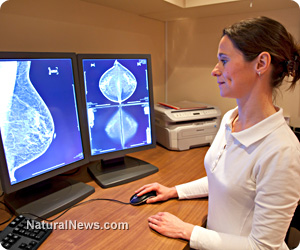
New technique uses 25 times less radiation to produce tumor images in high-resolution 3D
Wednesday, April 09, 2014 by: David Gutierrez, staff writer
Tags: breast cancer, tumor images, radiation
- CLOT SHOT PLANDEMIC UNFOLDING: Fibrous, rubbery clots caused by covid injections have prion-like seeding activity
- Widespread social and economic unrest: Steve Quayle issues urgent financial warning of imminent asset collapse in new interview with Mike Adams
- DEATH by VACCINE or face PRISON time: Canadian Freedom Convoy leaders CONVICTED for protesting forced vaccination during the Covid Plandemic
- How to detox from metals falling out of the sky
- Aerosolized bioweapons? Strange “diploid biomasses” falling out of the sky in Florida captured under the microscope
- How the peanut allergy epidemic was fueled by faulty science and institutional arrogance
- U.S. Military EXITS fake “Climate Change” hoax after a DECADE of wasting time, money, manpower and resources
- “Rockefeller Medicine Men”: Today’s healthcare crisis stems from the creation of the American medical establishment
- Rep. Jamie Raskin demands that 17 deported Tren de Aragua and MS-13 gang members be returned to the U.S. from El Salvador
- The hidden war above: Chemtrails, HAARP and the battle for planetary control
- Global financial Ponzi scheme collapses in real time as markets plummet, Mike Adams and Steve Quayle warn of impending chaos
- Analysis: The coming economic collapse, a mass uprising and Trump's three secret weapons to halt the growing revolt
- How Israeli military-connected corporations are secretly controlling your online privacy
- Washington State expands hate crime bill but ignores left-wing violence against Tesla owners
- Defunding DEADLY mRNA jabs: Government funding for mRNA technology being scrutinized and sidelined until proven "safe and effective" for real
- Elon Musk exposes widespread Social Security fraud: “Someone is going to be arrested”
- Mike Adams releases country western hit single: Goin’ Back in Time is Comin’ Home
- Kiss Your Genetic Privacy Good-Bye! 23andMe Gets Green Light to Sell Your Intimate Genetic Details to Anyone They Want
- Aerosolized bioweapons? Strange “diploid biomasses” falling out of the sky in Florida captured under the microscope
- European Court of Justice: Healthcare professionals who promoted or administered COVID-19 vaccines are CRIMINALLY LIABLE for any harm caused
- Newly released JFK files reveal Pentagon's role in creating Lyme disease and covid in the same lab
- Analysis: The coming economic collapse, a mass uprising and Trump's three secret weapons to halt the growing revolt
- FBI imposed gag order on agents to silence Hunter Biden laptop truth before 2020 election, new chat logs reveal
- Britain’s descent into police state censorship: Parents raided for questioning their daughter’s school system online
- “Project Aldrin”: Senate probes Meta's alleged censorship dealings with China
- Kiss Your Genetic Privacy Good-Bye! 23andMe Gets Green Light to Sell Your Intimate Genetic Details to Anyone They Want
- Oncologist warns of ‘terrifyingly aggressive’ cancers in children, linked to immune suppression from COVID vaccines
- Mike Adams releases country western hit single: Goin’ Back in Time is Comin’ Home
- Utah governor allows ban on LGBT pride flags in public buildings and schools, will take effect without his signature
- AI-powered forecasting model proves more accurate than traditional systems at predicting the weather
- When antibiotics are unavailable, natural ANTIMICROBIAL compounds become essential first line defenses against infection
- German researchers find link between mRNA vaccines and GENETIC CHANGES that precede CANCER and AUTOIMMUNE DISORDERS
- Defunding DEADLY mRNA jabs: Government funding for mRNA technology being scrutinized and sidelined until proven "safe and effective" for real
- The Health Ranger releases “Vaccine Zombie” song and music video, using AI-animated zombies for the music video
- Dr. Mary Talley Bowden drops bombshells about children being permanently damaged by mRNA jabs during Tucker Carlson interview
- The hidden war above: Chemtrails, HAARP and the battle for planetary control
- Newly released JFK files reveal Pentagon's role in creating Lyme disease and covid in the same lab
- California's social media censorship law struck down: A victory for free speech or a threat to online safety?
- The Health Ranger releases “Vaccine Zombie” song and music video, using AI-animated zombies for the music video
- Dr. Mike Yeadon releases 15-minute testimony - WATCH - about genocidal intent of COVID “vaccines”
- EPA advisor admits the agency is funneling billions to climate groups ahead of Trump’s return to White House
- Rep. Nancy Mace introduces bill to ban biological males from female facilities on federal property
- Mike Adams releases country western hit single: Goin’ Back in Time is Comin’ Home
- Florida takes a stand: DeSantis proposes permanent ban on mRNA vaccine mandates
- Sugarcane extract superior to cholesterol-lowering drugs?
- Survival 101: Effective EMF blocking techniques
- OpenAI whistleblower who dissented against how the company trained ChatGPT found dead
- CONSERVATIVES SOUND THE ALARM: Big Pharma and the Left trying to force $32 billion money grab from America’s seniors into year-end spending deal
- Pilots report mysterious lights 'moving at extreme speeds' across Oregon skies
- Attorney and TikTok influencer explains how he was offered hundreds of dollars to make false claims about Trump, Republicans
- Trump reverses course on Gaza plan, says “nobody is expelling Palestinians”
- Trump expected to choose Kelly Loeffler as his agriculture secretary even though she was caught INSIDER TRADING during COVID
- MEDICAL BOMBSHELL: FDA admits Covid mRNA 'Vaccines' CAUSE CANCER
- Marketing director responsible for WOKE Jaguar rebrand is also an LGBT activist who supports Black Lives Matter
- Red Cross issues warning to stop blood plasma donations from vaccinated people
- Scientists confirm: GENIUS brain function can be spontaneously unleashed in humans without any apparent cause
- EPA advisor admits the agency is funneling billions to climate groups ahead of Trump’s return to White House
- HYSSOP: What research reveals about the health benefits of this ancient holy herb
- Two containers with completed ballots fall out of truck in Florida
- Fully vaccinated about to see “tsunami” of illness and death, warns virologist
- Global leaders unite to clamp down on “misinformation” with UN-backed Cascais Declaration
- Newly released JFK files reveal Pentagon's role in creating Lyme disease and covid in the same lab
- BREAKING: 2025 NDAA authorizes mandatory military draft of WOMEN across America… as Pentagon pursues global NUCLEAR war with both Russia and China at the same time
- Michael Yon warns of a ZIONIST TAKEOVER in Trump’s second administration
- Ozempic and Wegovy weight loss drugs are injectable LIZARD VENOM PEPTIDES that may unleash a devastating wave of organ failure… side effects align with symptoms of SNAKE BITES
- BOMBSHELL: DNA testing kits are a SCAM to develop ethnic-specific bioweapons
- The Health Ranger releases “Vaccine Zombie” song and music video, using AI-animated zombies for the music video
- Israeli soldiers accused of even more torture and abuse in the West Bank
- These 13 countries just signed an agreement to engineer a global FAMINE by destroying food supply
- NASA admits that climate change occurs because of changes in Earth’s solar orbit, and NOT because of SUVs and fossil fuels
- RFK Jr. clears key hurdle: Sen. Susan Collins backs controversial HHS nominee, signaling a new era for health policy
- Sermon 30: How Jesus reveals Caesar’s FAKE CURRENCY and FALSE AUTHORITY
"This new technique can open up the doors to the clinical use of computed tomography [CT] in the breast diagnosis, which would be a powerful tool to fight even better and earlier against breast cancer," said Maximilian Reiser of the Ludwig Maximilians University in Munich (LMU), one of the researchers who helped develop the technique.
Early detection is linked to significantly improved breast cancer outcomes. Currently, the standard breast cancer screening method is "dual-view digital mammography," which uses radiation to take two separate images of the breast. Because these mammograms render a three-dimensional organ in only two dimensions, they typically fail to detect 10 to 20 percent of tumors. In addition, 2D mammograms often render false positives, as normal tissue can take on a strange appearance when flattened into two dimensions.
Although 3D CT scans produce much-higher-resolution images than 2D mammograms, they typically require much more radiation to do so. This prevents their use in routine cancer screening -- particularly for highly radiation-sensitive organs such as the breast.
Advanced techniques use less radiation
The new, lower radiation CT scan was tested in a study published in the Proceedings of the National Academy of Sciences in October 2012. The technique was developed by physicists, radiologists and mathematicians from LMU, the European Synchrotron Radiation Facility, and the University of California-Los Angeles.The researchers achieved such a dramatically lower radiation dose by changing three separate factors of normal CT scans. The first change involved replacing standard X-rays with high-energy X-rays which are more likely to pass through tissue and thereby expose the body to six times less radiation. The second change involved a technique called "phase contrast imaging," which requires fewer X-rays to produce the same image. The third change involved reducing the number of X-rays even further and then applying a mathematical algorithm called "equally sloped tomography" (EST) to reconstruct a higher-resolution image.
In the 2012 study, the researchers successfully used the EST algorithm to produce a high-resolution, 3D image of the breast using 25 times less radiation than a mammogram. They then took images of the same breast using several other standard 3D imaging techniques. In a blind test, five independent LMU radiologists all ranked the images produced from the new technique as having the best contrast, sharpness and image quality.
"Three-dimensional reconstructions, like the ones created in this research, are produced using sophisticated software and a powerful computer that can combine many images into one 3-D image, much like the slices of an orange," UCLA researcher Jianwei (John) Miao said. "By rethinking the mathematic equations of the software in use today, we developed a more powerful algorithm that requires fewer slices to get a clearer 3-D picture."
Applications still far off
"After dramatically reducing the dose delivered during the examination of the breast, our next objective is to develop this technique in the early visualisation of other human diseases and to work towards its clinical implementation," said researcher Paola Coan.Unfortunately, it may be some time before the new technique is ready for regular use. One of the major hurdles is the need to produce an X-ray source small enough to be practical at hospitals.
"Many research groups are actively working to develop this device and once this hurdle is cleared, the new X-ray technique is poised to make a big impact on society," researcher Emmanuel Brun said.
Sources for this article include:
http://www.esrf.eu
http://www.esrf.eu
http://science.naturalnews.com
Breast cancer at FETCH.news
Get independent news alerts on natural cures, food lab tests, cannabis medicine, science, robotics, drones, privacy and more.
Take Action: Support Natural News by linking to this article from your website
Permalink to this article:
Embed article link: (copy HTML code below):
Reprinting this article:
Non-commercial use OK, cite NaturalNews.com with clickable link.
Follow Natural News on Facebook, Twitter, Google Plus, and Pinterest
Science News & Studies
Medicine News and Information
Food News & Studies
Health News & Studies
Herbs News & Information
Pollution News & Studies
Cancer News & Studies
Climate News & Studies
Survival News & Information
Gear News & Information
News covering technology, stocks, hackers, and more



"Big Tech and mainstream media are constantly trying to silence the independent voices that dare to bring you the truth about toxic food ingredients, dangerous medications and the failed, fraudulent science of the profit-driven medical establishment.
Email is one of the best ways to make sure you stay informed, without the censorship of the tech giants (Google, Apple, Facebook, Twitter, YouTube, etc.). Stay informed and you'll even likely learn information that may help save your own life."
–The Health Ranger, Mike Adams













































